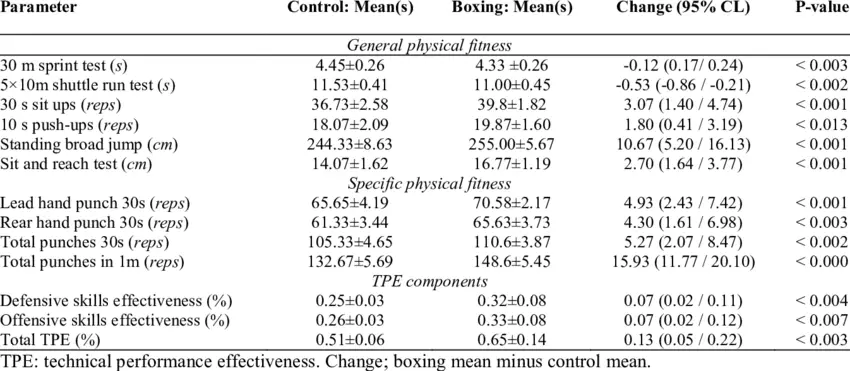Many people seem to think they don’t have enough free time to box, let alone exercise regularly. However, such a thought is a symptom of a more significant problem, a lack of motivation and reasons to start boxing. So, how long are boxing classes?
On average, boxing sessions are 60 minutes long. However, depending on your free time and intensity, they can range from 20 to 120 minutes daily. For instance, if you want to become a professional boxer and focus full-time on boxing, you will need 120+ daily boxing minutes, 3-5 times per week.
The more intense a boxing session is, the shorter it can be. So, for instance, if you have 20 minutes to spare in your day and want to fill it up with a boxing session, you can use shadowboxing, for example.
This will allow you to keep training without that much time to spare. That said, it’ll be better to attend a regular boxing gym and train there. This will ensure you progress much faster and learn the craft more thoroughly than if you were to box alone.
This article will give you anything you need to know about how long to box for and how to train like the pros. Before we dive in, however, if you want to be more comfortable while boxing, here are the best boxing pieces of clothing you can buy; follow the link to learn more.
How long should my boxing session be?
Boxing can be intense. Therefore, you might put your body under high-stress levels due to long boxing sessions. That’s why you must train for a proper amount of time, both helping you progress while avoiding overtraining.
As a general rule, your boxing sessions should last 60 minutes. However, if you’re not that free, you can intensify the training while shortening it to 10-30 minutes. Likewise, if you want to work on your technique and have some time to spare, you can lower the intensity and work for 120 minutes.
According to a study, “Boxing intervention was more efficient to develop physical fitness and TPE variables better than traditional intervention.”

As you can see, the boxers were able to perform much better than the control group in the study. Making it a solid exercise!
The study included 3 workouts per week, each lasting 120 minutes—for 8 weeks. However, it also had various physical fitness exercises, such as sprints and running. So, not all 120 minutes were invested in boxing training.
So, don’t think that 120 minutes of boxing—is standard. In some sessions, you’ll burn up to 800 calories per hour. Hence, up to 1600 calories.
Your body will need time to recover. However, you can take various steps to recover faster, such as eating correctly and sleeping sufficiently.
So, how much sleep do you need?

7-9 hours per night
SOURCE
If you want to learn about how much and what to eat, follow the link to a complete guide I wrote on the topic.
How many daily hours of boxing do I need?
Suiting your training routine to your schedule—is critical. For instance, you can set aside 40 minutes of daily exercise in your schedule. However, life eventually intervenes. So, setting aside a realistic amount of time—will correlate with your consistency in the long term.
As a general rule, you need about 60 minutes of daily boxing to become a better boxer. Therefore, training up to 5 times a week—is often the most optimized way you can train – if you want to turn pro. However, for most boxers, training up to 3 times a week—provides a good balance between training and resting.
Resting and recovering should be your primary concern, especially if you’re a beginner. If you want to train optimally, you must ensure your body is ready for all the stress you’ll be putting through.
If you ignore how your muscles react to boxing training, you’ll also be more likely to injure yourself through overtraining.
Overtraining can have highly severe symptoms, such as enjoying life less. As such, training daily—might be a bad idea, especially without a coach and especially for beginners.
I always recommend starting with 60 minutes of boxing, up to 3 times per week, on non-consecutive days. That means that if you train on Sunday, your next class should be on Tuesday/Wednesday.
| Sunday | Monday | Tuesday | Wednesday | Thursday | Friday | Saturday |
|---|---|---|---|---|---|---|
| Boxing | Rest | Boxing | Rest | Rest | Boxing | Rest |
Boxing can be a challenging sport. If you want to be more stable inside the ring and slip less, consider pairing yourself with boxing shoes. If you want to see which are the best boxing shoes for your money, follow the link to an article of mine listing the best ones!
How long should beginner boxers train?
If you’re starting your training, you’re not alone. All professional boxers have started from where you are, not that long ago. You can, however, implement various methods to ensure you progress optimally.
Most beginner boxers, on average, should train for about 60-120 minutes per session, up to 4 times per week. However, this will demand plenty of time inside your schedule. If you don’t have much time to invest in boxing, you can even box once a week for 60-120 minutes and still expect solid results.
It’s even more important for beginners, however, to recover. You’ll be much more likely to overtrain your body if you’re in the beginning phase of your training.
You’ll be more eager to attend the following session when you first start doing anything. For instance, when I first started training in Muay Thai, I couldn’t stop myself from going out for an outdoor punching bag workout.
Nevertheless, I had to force myself to continue learning after a few weeks.
There’s a concept in Zen Buddhism that’s called “a beginner’s mind.” It’s essentially when you view the world with a fresh set of eyes and excitement like beginners do.”
The same applies to boxing. It’ll always be best to attend your next session with a new set of eyes. If you can do that, you’ll be more likely to remain excited about boxing while ensuring you don’t overtrain. In addition, coming with a beginner’s mind will help you learn more and judge less.
How often should I box?
Although it may contrast everything you have heard so far, hear me out. Resting and recovering your muscles should be your top priority. When you overtrain, not only will you not progress, but you’ll move backward.
While professional boxers train daily, beginner boxers should train up to 3 times a week to ensure their body recovers and rests appropriately. However, even professional boxers can’t go all-out every day and expect their bodies to keep up. Therefore, sparing time in your training schedule to recover—is critical.
Some professional boxers even train daily. However, they’re smart about their training. So they won’t go all-in on the same training as the day before.
They would find their body is worn-out if they were to do that. That’s why coaches exist, to ensure you train optimally. Eventually, this can be the difference between overtraining and progressing.
Symptoms and warning signs of overtraining
- Unusual muscle soreness after a workout, which persists with continued training.
- Inability to train or compete at a previously manageable level.
- “Heavy” leg muscles, even at lower exercise intensities.
- Delays in recovery from training.
- Performance plateaus or declines.
According to a medical article, “One study found that it took 72 hours of rest — or 3 days — between strength training sessions for full muscle recovery, while research from the ACE Scientific Advisory Panel says that a recovery period could be anywhere from two days up to a week depending on the type of exercise.”
If you want to learn how often professional boxers train, follow the link to an article of mine on the topic.
How do professional boxers train?
To become a pro, you must also train like the pros. A part of their success is their mindset and not only their training routine. So, before you even begin training like them, it’ll be best to adopt a solid attitude to help you perform better.
Professional boxers train in various ways, such as shadowboxing, sparring, heavy bag training, pad work, and numerous cardio workouts, such as running, swimming, and jumping rope. Combining these ways allows them to condition their entire body while also enjoying training and getting more results.

All these workouts will give you plenty of results. For example, sparring, heavy bag training, and pad work—are the best ways to ensure your boxing progression.
This is especially true if you’re a beginner. At your level, imitating and listening to people you look up to—will help you progress faster.
Examples of professional boxers training
Seeing and learning from professional boxers’ training routines—is more valuable than you think. I’m not telling you to imitate them. But you can know what works and what doesn’t by watching them.
For instance, you’ll never see a pro boxer perform various useless drills; Instead, you’ll see him performing exercises that do work, such as pad work and sparring.
Then, you can feel more confident in these drills, helping you progress. This section will focus on three primary examples of professional boxers’ exercises.
If you want to turn pro, you must also train like them. Push your physical boundaries with each training session like they do. So, without further ado, let’s dive in.
#1 – Shadowboxing
Shadowboxing is one of the best training methods boxers use to hone their technique and boost their confidence.
The primary trait of shadowboxing is that you can do it anywhere and whenever you want. So you can even stop reading this article and start working on your boxing technique.
That’s why it’s also trendy. Have you ever seen a martial arts movie, such as Karate Kid, without the main character shadowboxing on a mountain with a perfect view? I sure haven’t.
Pro boxers use it to hone their technique and visualize themselves fighting. Visualization can help boost confidence toward a big fight, as it can help you perform better without giving in to distractions.
Try to involve shadowboxing in your training; you won’t regret it.
#2 – Sparring
Sparring is one of the essential boxing workouts you can do if your goal is to progress. Professional boxers always do it, and that’s why they’re always ready for their next fight.
Nevertheless, it’s the closest you’ll get to actual fighting in your training. Therefore, it’s also the riskiest training method since it has the highest injury risk.
As a result, it’ll be best always to wear protective gear, including headgear, hand wraps, and boxing gloves when sparring. That will minimize your risk for injuries.
If you want to protect your head, follow the link to learn about the best boxing headgear for your money.
I highly encourage you to spar. However, don’t jump into deep waters and start sparring when you first begin boxing. You’ll only end up hurting yourself if you jump too deep without having prior experience.
#3 – Heavy bag training
Heavy bag training can be an intense and beneficial workout. It can be a cornerstone in your boxing training if you focus on your technique.
That can be not easy sometimes, as you want to go all-in on the heavy bag. However, going slow is especially important for beginner boxers who still need to work on their technique.
Seeing pro boxers train—will enrich your knowledge and give you a peek at how they train to reach such top levels. While your boxing classes won’t look like you’re preparing for a championship, it’s still essential to understand how the best boxers train.
You can take heavy bag training in many directions. For instance, you can work on your punching technique, or you can work on your combinations. You’ll be fine if you work on something and do not just go all-in, only to end up hurting yourself.
Heavy bag training can be problematic for your joints. Follow the link if you want to learn how to protect your joints in your boxing classes.
Final words
Before we wrap up the article, I want to emphasize the importance of training correctly. If you start training without previous experience or knowledge, you’re more likely to injure yourself in the process.
That’s why you should always pay attention to how much you train before it’s too late. If you overtrain your body before it’s ready, you won’t step inside the boxing gym in the near future. Such a result will set you back many steps back.
So, watch your training schedule and enjoy training!
If you enjoyed reading this article, you’d also enjoy the complete guide to breathing correctly in boxing. If you perfect your breathing in boxing, your skills will boost immediately. So, give it a look.

